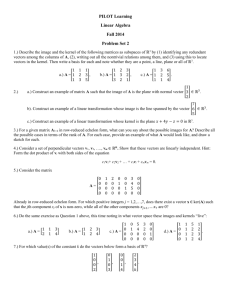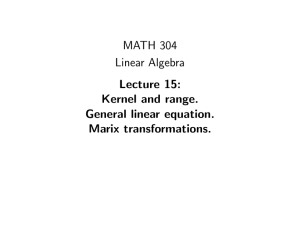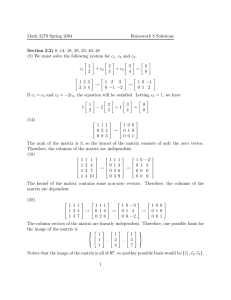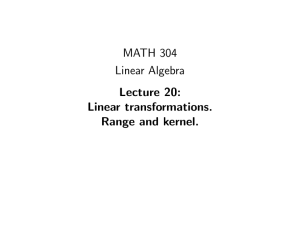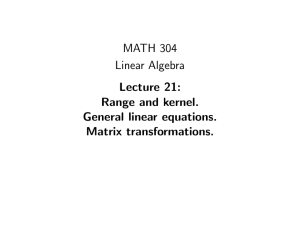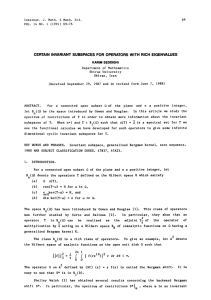Solutions to the sample midterm test 2011
advertisement
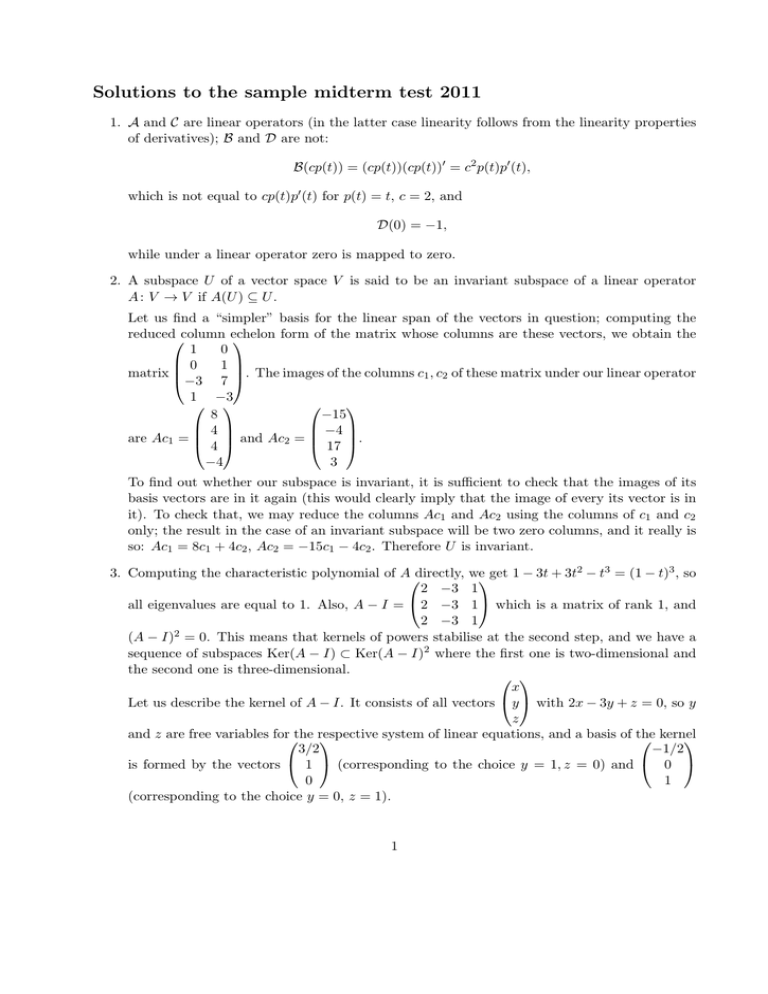
Solutions to the sample midterm test 2011 1. A and C are linear operators (in the latter case linearity follows from the linearity properties of derivatives); B and D are not: B(cp(t)) = (cp(t))(cp(t))0 = c2 p(t)p0 (t), which is not equal to cp(t)p0 (t) for p(t) = t, c = 2, and D(0) = −1, while under a linear operator zero is mapped to zero. 2. A subspace U of a vector space V is said to be an invariant subspace of a linear operator A : V → V if A(U ) ⊆ U . Let us find a “simpler” basis for the linear span of the vectors in question; computing the reducedcolumn echelon form of the matrix whose columns are these vectors, we obtain the 1 0 0 1 matrix −3 7 . The images of the columns c1 , c2 of these matrix under our linear operator 1 −3 8 −15 4 −4 are Ac1 = 4 and Ac2 = 17 . −4 3 To find out whether our subspace is invariant, it is sufficient to check that the images of its basis vectors are in it again (this would clearly imply that the image of every its vector is in it). To check that, we may reduce the columns Ac1 and Ac2 using the columns of c1 and c2 only; the result in the case of an invariant subspace will be two zero columns, and it really is so: Ac1 = 8c1 + 4c2 , Ac2 = −15c1 − 4c2 . Therefore U is invariant. 3. Computing the characteristic polynomial of Adirectly, weget 1 − 3t + 3t2 − t3 = (1 − t)3 , so 2 −3 1 all eigenvalues are equal to 1. Also, A − I = 2 −3 1 which is a matrix of rank 1, and 2 −3 1 (A − I)2 = 0. This means that kernels of powers stabilise at the second step, and we have a sequence of subspaces Ker(A − I) ⊂ Ker(A − I)2 where the first one is two-dimensional and the second one is three-dimensional. x Let us describe the kernel of A − I. It consists of all vectors y with 2x − 3y + z = 0, so y z and z are free variables forthe respective system of linear equations, and a basis of the kernel 3/2 −1/2 is formed by the vectors 1 (corresponding to the choice y = 1, z = 0) and 0 0 1 (corresponding to the choice y = 0, z = 1). 1 To find a basis of the kernel of (A−I)2 (which is in our case the whole vector space R3 ) relative to the kernel of A − I, we find the reduced column echelon form of the matrix whose columns form a basis of the kernel, and take the standard unit vectors that make up for the “missing 1 0 leading 1’s”. In this case, the reduced column echelon form is given by the matrix 0 1, −2 3 0 therefore the missing leading 1 is provided by the third standard unit vector f = 0. This 1 1 vector gives rise to the thread f, (A − I)f = 1. 1 The vector (A − I)f belongs to the kernel of A − I, and to complete the construction of a Jordan basis, we should find a basis of the kernel relative to the span of that vector. To do that, we reduce the columns of the reduced column echelon form we found above using this 0 0 0 0 vector, obtaining the matrix −1 1 whose reduced column echelon form is 1 0, and −3 3 3 0 0 the only nonzero column e = 1 can be chosen as a relative basis vector. Overall, for a 3 Jordan basis for our matrix we may choose (A − I)f, f, e (we reversed the order of vectors in 1 1 0 threads), and the Jordan normal form is 0 1 0. 0 0 1 From class, we know that two matrices represent the same linear operator if and only if they have the same Jordan normal forms, for which it is enough to check that they have the same eigenvalue, and for each eigenvalue λ the dimensions of kernels coincide: dim Ker(A − λI)k = dim Ker(B − λI)k . It is easy to see that all eigenvalues of B are equal to 1, that B − I has rank 1 (and therefore a two-dimensional kernel), and (B − I)2 = 0, which means that B and A indeed represent the same operator in different coordinate systems. 2
